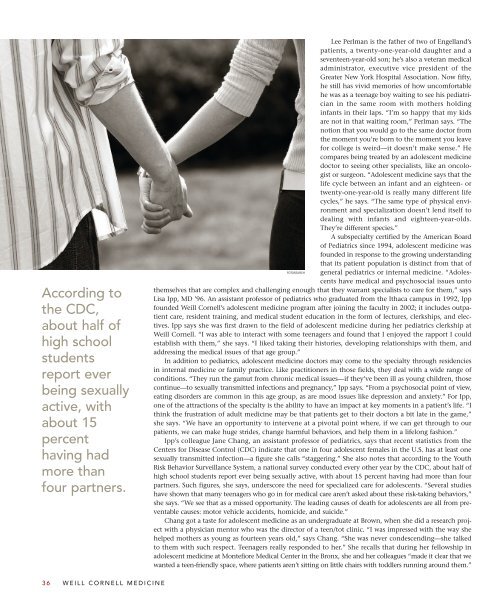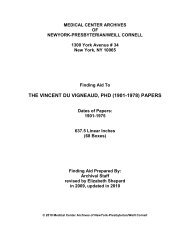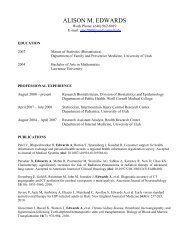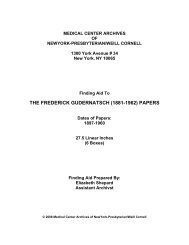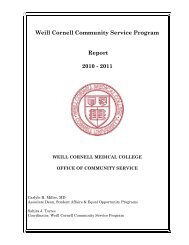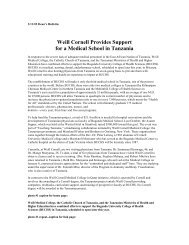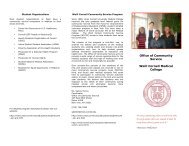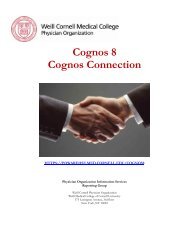Weillcornellmedicine - Weill Medical College - Cornell University
Weillcornellmedicine - Weill Medical College - Cornell University
Weillcornellmedicine - Weill Medical College - Cornell University
Create successful ePaper yourself
Turn your PDF publications into a flip-book with our unique Google optimized e-Paper software.
According to<br />
the CDC,<br />
about half of<br />
high school<br />
students<br />
report ever<br />
being sexually<br />
active, with<br />
about 15<br />
percent<br />
having had<br />
more than<br />
four partners.<br />
36 WEILL CORNELL MEDICINE<br />
Lee Perlman is the father of two of Engelland’s<br />
patients, a twenty-one-year-old daughter and a<br />
seventeen-year-old son; he’s also a veteran medical<br />
administrator, executive vice president of the<br />
Greater New York Hospital Association. Now fifty,<br />
he still has vivid memories of how uncomfortable<br />
he was as a teenage boy waiting to see his pediatrician<br />
in the same room with mothers holding<br />
infants in their laps. “I’m so happy that my kids<br />
are not in that waiting room,” Perlman says. “The<br />
notion that you would go to the same doctor from<br />
the moment you’re born to the moment you leave<br />
for college is weird—it doesn’t make sense.” He<br />
compares being treated by an adolescent medicine<br />
doctor to seeing other specialists, like an oncologist<br />
or surgeon. “Adolescent medicine says that the<br />
life cycle between an infant and an eighteen- or<br />
twenty-one-year-old is really many different life<br />
cycles,” he says. “The same type of physical environment<br />
and specialization doesn’t lend itself to<br />
dealing with infants and eighteen-year-olds.<br />
They’re different species.”<br />
A subspecialty certified by the American Board<br />
of Pediatrics since 1994, adolescent medicine was<br />
founded in response to the growing understanding<br />
that its patient population is distinct from that of<br />
FOTOSEARCH<br />
general pediatrics or internal medicine. “Adolescents<br />
have medical and psychosocial issues unto<br />
themselves that are complex and challenging enough that they warrant specialists to care for them,” says<br />
Lisa Ipp, MD ’96. An assistant professor of pediatrics who graduated from the Ithaca campus in 1992, Ipp<br />
founded <strong>Weill</strong> <strong>Cornell</strong>’s adolescent medicine program after joining the faculty in 2002; it includes outpatient<br />
care, resident training, and medical student education in the form of lectures, clerkships, and electives.<br />
Ipp says she was first drawn to the field of adolescent medicine during her pediatrics clerkship at<br />
<strong>Weill</strong> <strong>Cornell</strong>. “I was able to interact with some teenagers and found that I enjoyed the rapport I could<br />
establish with them,” she says. “I liked taking their histories, developing relationships with them, and<br />
addressing the medical issues of that age group.”<br />
In addition to pediatrics, adolescent medicine doctors may come to the specialty through residencies<br />
in internal medicine or family practice. Like practitioners in those fields, they deal with a wide range of<br />
conditions. “They run the gamut from chronic medical issues—if they’ve been ill as young children, those<br />
continue—to sexually transmitted infections and pregnancy,” Ipp says. “From a psychosocial point of view,<br />
eating disorders are common in this age group, as are mood issues like depression and anxiety.” For Ipp,<br />
one of the attractions of the specialty is the ability to have an impact at key moments in a patient’s life. “I<br />
think the frustration of adult medicine may be that patients get to their doctors a bit late in the game,”<br />
she says. “We have an opportunity to intervene at a pivotal point where, if we can get through to our<br />
patients, we can make huge strides, change harmful behaviors, and help them in a lifelong fashion.”<br />
Ipp’s colleague Jane Chang, an assistant professor of pediatrics, says that recent statistics from the<br />
Centers for Disease Control (CDC) indicate that one in four adolescent females in the U.S. has at least one<br />
sexually transmitted infection—a figure she calls “staggering.” She also notes that according to the Youth<br />
Risk Behavior Surveillance System, a national survey conducted every other year by the CDC, about half of<br />
high school students report ever being sexually active, with about 15 percent having had more than four<br />
partners. Such figures, she says, underscore the need for specialized care for adolescents. “Several studies<br />
have shown that many teenagers who go in for medical care aren’t asked about these risk-taking behaviors,”<br />
she says. “We see that as a missed opportunity. The leading causes of death for adolescents are all from preventable<br />
causes: motor vehicle accidents, homicide, and suicide.”<br />
Chang got a taste for adolescent medicine as an undergraduate at Brown, when she did a research project<br />
with a physician mentor who was the director of a teen/tot clinic. “I was impressed with the way she<br />
helped mothers as young as fourteen years old,” says Chang. “She was never condescending—she talked<br />
to them with such respect. Teenagers really responded to her.” She recalls that during her fellowship in<br />
adolescent medicine at Montefiore <strong>Medical</strong> Center in the Bronx, she and her colleagues “made it clear that we<br />
wanted a teen-friendly space, where patients aren’t sitting on little chairs with toddlers running around them.”


